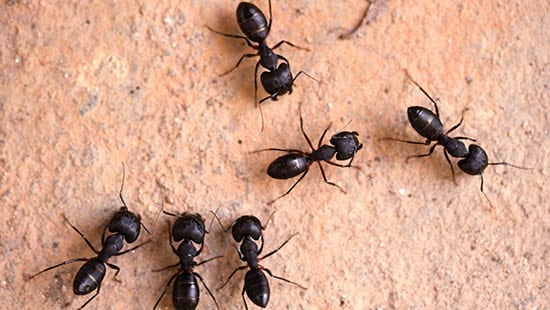Ants: Complex but Controllable Pests

Controlling ants is complex because of the vast number of ant types and the biological, behavioral and feeding differences of each. There are more than 12,400 ant species throughout the world and about 1,000 known species in the U.S. While only about 25 of those are considered pests, and even fewer tend to inhabit any one geographic area, even a single ant in a food processing facility can indicate a bigger problem and negatively impact food safety. Thus, identifying the kind of ant is critical to its control and elimination.
Understanding Ant Behavior
Effective elimination relies on understanding the feeding and social behavior of the invading ants. As examples: If bait is placed in an area where they don’t travel, or it consists of a food ingredient which it is not attracted to, the bait will do little except collect dust. If you look for an ant nest outdoors but the colony is an indoor-nesting ant, the time will be spent in vain. If only a single colony of a multi-nest ant is found and treated, the infestation is unlikely to be eliminated.
Even within an ant species, complexities can arise. For example, the pavement ant often will nest under sidewalks and driveways in temperate weather – then move indoors during the winter, nesting under the foundation or near a heat source. They also can have seasonal variations in food preferences, with many foraging for proteins in the spring as they work to build up the colony, then preferring more sugar/carbohydrates in the summer and fall.
Effective Commercial Ant Control
Baits are the most effective form of treatment for the majority of ants, especially those which invade structures.* This is because the worker ants will feed on the bait, which contains an attractant and an insecticide, and carry it back to the nest to share with other colony members, including the reproductive queen. Once the queen is eliminated, the colony stops producing new ants and will ultimately perish. If control tactics only target worker ants and never reach the queen, the colony will continue to produce new ants and the issues will persist.
For ant species or situations where bait is not effective or appropriate, other methods may be necessary, such as physical elimination of the nest (if possible), or a targeted treatment of a carefully-selected residual insecticide by a trained professional.
Beyond Baits: What You Can Do to Keep Ants Out
For a bait to be most effective, access to alternate food and water sources needs to be reduced as much as possible. This means maintaining a sanitary environment, cleaning up spills and crumbs, keeping garbage emptied, repairing leaks and eliminating equipment harborage areas. It also is important to understand that bait does not take effect immediately, but it is a long-term solution. While it can take a week or two to stop seeing ants, feeding bait to the colony and queen enables a complete elimination of the ants you don’t see, instead of just the workers that you do.
*Although bait is generally the best choice for controlling ants, applicators need to always ensure the specific application is listed on the label and allowed by the food plant’s third-party audit standards, and that the bait is on the approved products list before any applications are made.
More Pest Resources
Ants can cause serious problems for your business. Use this guide to identify common types of ants so you can confidently maintain a pest-free facility.
A key to dealing with ants at your facility is knowing how to locate an ant nest and understanding what attracted the ants in the first place.
With their potential to bite, sting and contaminate food, ants are more than just a nuisance. Ant elimination services help control a variety of ants.
Large flies can transmit at least 65 diseases to humans, making fly control particularly important for restaurants and food retail.




